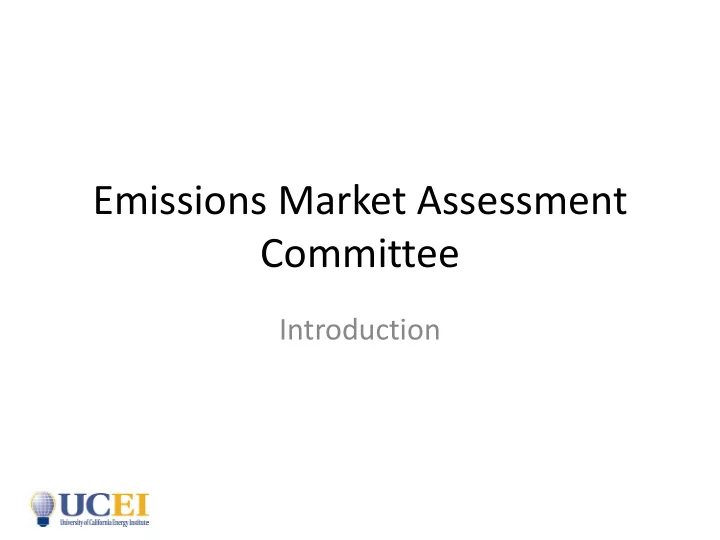

Emissions Market Assessment Committee Introduction
Agenda • Four Aspects of Cap-and-Trade Market – Resource Shuffling Policy – Reserve Price Policy • Update on MSG modeling – Linkage Policy – Information Availability Policy • Public comment: other topics
Resource Shuffling
Resource Shuffling: Outline • Definitions and potential scope • Policy Options – Legal enforcement approaches – Market adjustment approaches • Options for analysis
Resource Reshuffling • Academic Definition : Changes in pair-wise matches of buyers and sellers that do not result in changes of emissions – Combined emissions of importing and exporting regions • Policy Definition has been adjusted to account for reductions in CA GHG consumption triggered by complimentary measures – For example SB 1368
Pathways to Reshuffling • Default emissions rates: relabeling – May be possible to import same power at lower emissions rate if it was higher than default • Specified sources – May be possible to import from clean specified sources that had not previously been selling to CA – This could be swapped out for dirtier historic import sources • Higher defaults decrease in incentives for the first, increase incentives for the second
Scope for Reshuffling & Relabeling • 2010 Emissions from Electricity Imports about 55 mmTons – For 90 TWh of energy – About 20 TWh was zero carbon source – Average Intensity of 55/70 = .785 tons/MWh for the rest • If all 70 TWh was substituted for zero carbon sources – 55 mmTon/year reduction • If all was scored at default of .436 mmTons/MWh – About 25 mmTon/year redution
Estimating Scope for Reshuffling
2007 Re-dispatch w/ Carbon Regulation: 15% reduction
Approaches for Dealing with Reshuffling • Expand the number of participating jurisdictions • Ad-hoc regulatory oversight of procurement – CPUC procurement proceedings – SB 1368 • Legal prohibitions • Market-Design changes
Legal Enforcement • Original language “I certify under penalty of perjury of the laws of the State of California that [facility or company name] for which I am an agent has not engaged in the activity of resource shuffling to reduce compliance obligation for emissions, based on emission reductions that have not occurred as reported under MRR.”
Legal Prohibitions • Pros: – Appealing in its apparent breadth and simplicity – Preserves freedom of action for enforcement? – Does not require design changes • Cons: – If too open-ended, can disrupt wholesale electricity market – Probably very difficult to strictly enforce • Must distinguish between transactions motivated by “reducing compliance obligation” from other motivations • What will be the burden of proof?
EMAC view • Very difficult to distinguish between transactions motivated by reshuffling vs. other reasons • Emphasizing broad, undefined, legal enforcement can yield the market to those willing to bear legal risk • Favor identifying types of transactions explicitly as reshuffling – Rather than a growing list of what is not
Examples • One type of reshuffling (for purposes of enforcement) a market participant claiming a source for imported electricity to be a specific generating unit when it can later be determined that this imported energy was procured from a different generating unit with an emissions rate that is higher than the one originally claimed as the source of that energy.
Joint Proposal by IOUs • Identifies 6-7 activities that would not constitute reshuffling (for purposes of enforcement) – RPS compliance – Compliance with other regs – Retirement of resource – Termination of contracts for “other reasons” – Expiration of contract – Short-term transactions – Transmission constraints, outages, or emergencies
Market Adjustment Approaches • In ARB Chair’s August letter, ARB considering “adjustments to ensure that emission reductions that occur in the electricity sector as a result of California’s cap and trade program are not offset by increases in emissions elsewhere.” • Anticipate or measure degree of reshuffling and adjust cap and/or allocations accordingly – How could that be approached?
Market Adjustments: Three Large Issues • Where does adjustment come from? • How much of an adjustment? • Where does adjustment go?
Where does adjustment come from? • Reduce unallocated auction amount? • Reduce allocations pro-rata? – Come from all industries? – Reductions focused on Electricity? • Link adjustment to market actions – Link adjustments to market actions? • What kind of actions? Anything not on IOU guidance list?
Adjustment • How much of an adjustment? – Anticipate potential reshuffling? – Respond to specific market actions? • Where does it go? – Into the auction pool? – Retired? – Into the price-reserve?
Assessing Impact of Remedies • Potential for reshuffling – ``pure’’ market potential is large – ``soft’’ factors hard to quantify • Regulatory oversight (e.g. CPUC procurement) • Trade frictions on low GHG power • Warm glow vs. Hot glare • Potential market impacts of adjustments – Impacts on expected prices – Impacts on volatility of prices
Complimentary Measures • Very possible that external shocks (rainfall, economy) combined with complimentary policies will yield reductions necessary to meet the cap – An outcome where the market price is at or near the floor does not therefore imply a ``failure’’ of the cap-and-trade program
Supply of Abatement Allowance Price 50 40 Electricity Dispatch Changes; Industrial Processes Changes; Fuels Consumption Changes Offsets Costly Complementary Costless Reshuffling Measures Reshuffling 0 GHG Reductions
Recommend
More recommend